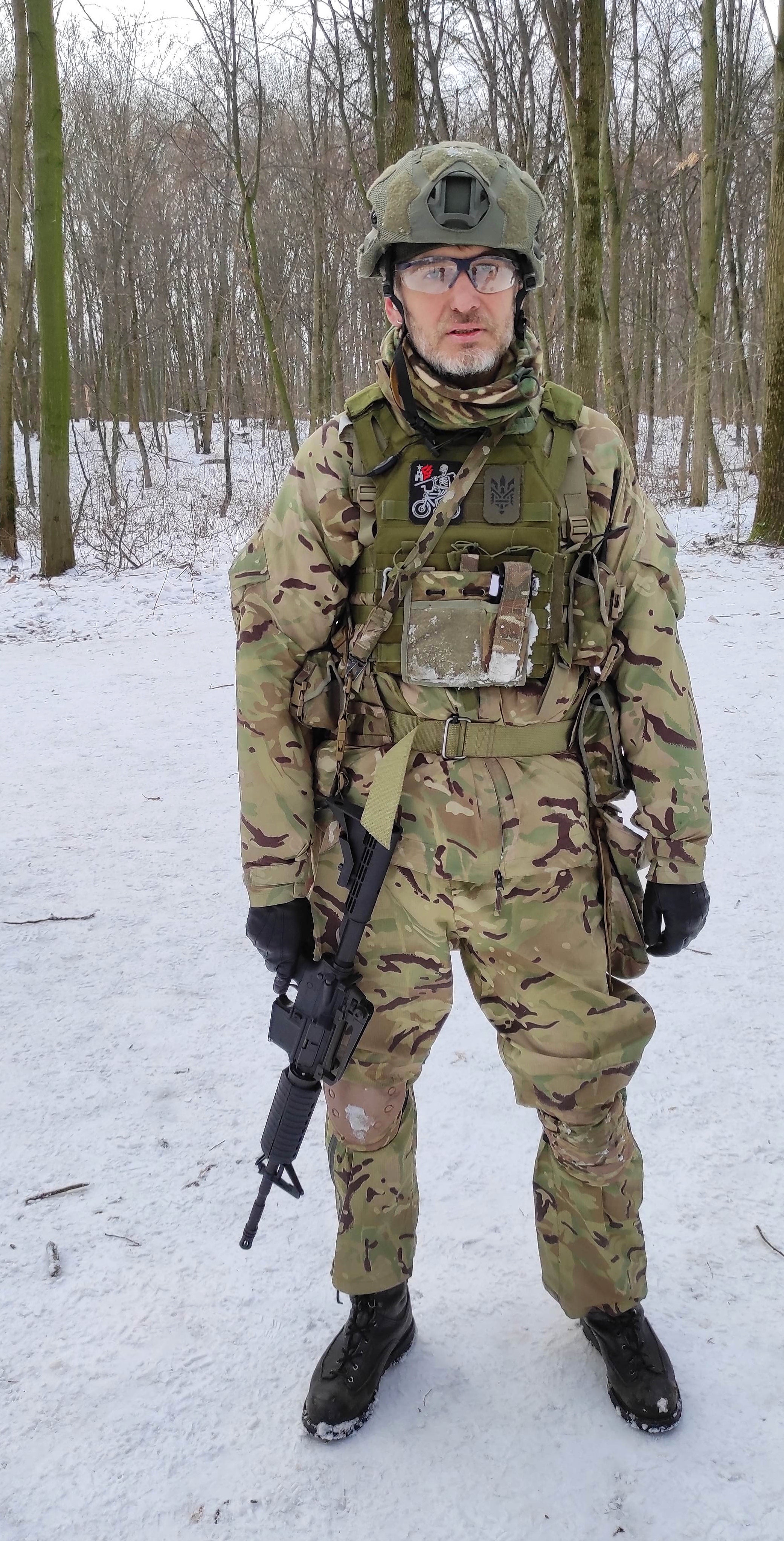‘What choice have we got?’: Ukraine’s volunteer army prepares for war
As fears over a war with Russia grow, Ukraine’s forces are being bolstered by a collection of citizen soldiers, reports Kim Sengupta in Kiev


Your support helps us to tell the story
From reproductive rights to climate change to Big Tech, The Independent is on the ground when the story is developing. Whether it's investigating the financials of Elon Musk's pro-Trump PAC or producing our latest documentary, 'The A Word', which shines a light on the American women fighting for reproductive rights, we know how important it is to parse out the facts from the messaging.
At such a critical moment in US history, we need reporters on the ground. Your donation allows us to keep sending journalists to speak to both sides of the story.
The Independent is trusted by Americans across the entire political spectrum. And unlike many other quality news outlets, we choose not to lock Americans out of our reporting and analysis with paywalls. We believe quality journalism should be available to everyone, paid for by those who can afford it.
Your support makes all the difference.One thing Oleksii Bida remembers vividly from the time he was kidnapped and tortured was that his interrogators knew full well that he could not answer the questions he was being asked.
Naked, tied to a chair while being repeatedly kicked and punched, he was told his ordeal would be over as soon as he revealed the “secrets of the traitors” who were taking part in the 2014 Euromaidan protests in Luhansk.
“But I knew no secrets. We were demonstrating just as people were demonstrating in Kiev and so many other cities all over the country. I knew that and they knew that. I guess they just liked hurting the people they hated,” reflected the 47-year-old graphic designer.
At the time of his brutal encounter with the separatist militiamen during the protests eight years ago, which led to a bloody conflict and the effective partition of Ukraine, Mr Bida was an avowed pacifist as well as being a civil rights activist.
Last weekend he was in camouflage and body armour, carrying weapons, and vowing to fight and kill if Vladimir Putin orders an attack on his country; an attack which he thinks may now be quite likely.
Mr Bida is part of Ukraine’s army reserves and Territorial Defence Force (TDF) who, along with citizen volunteers, can now be found in parks and woods carrying out drills and military exercises in increasing numbers as the warnings of imminent strife grow.
These men and women are not, the Ukrainian military wants to point out, playing at soldiers. They are a highly important part of the country’s military strategy when any invasion takes place especially if, as expected, there is ground combat near or in urban centres.
A survey last month by Kiev International Institute of Sociology reported that 58 per cent of men and 13 per cent of women in the country’s population of 44 million were prepared to take part in armed resistance against a Russian attack. Around 17 per cent of men and 25.5 per cent of women were ready to use other means, including protests and sabotage against aggression.
These figures are believed to have risen sharply in the past month and training for the volunteers has been drastically stepped up. Thousands are turning up for exercises, with applications rocketing to join the 12,000 members of the TDF who are scheduled to be absorbed into the ranks of the 250,000-strong military this year.
The sharp rise in numbers comes amid apprehension that the build-up of a force of more than 100,00 Russian troops has gone beyond intimidation to gain diplomatic concessions from Ukraine, and a military offensive now seems the likeliest scenario.
I can’t just sit at home and let others do what needs to be done. The fact that I am a woman is neither here nor there
Around 50 volunteers, men and women, young and old, who turned up on a Ukrainian winter morning of snow and biting cold wind were determined, they said, to do what they could. They did not, at first glance, look like those who would survive long against the firepower of tanks, missiles and artillery ranged against them. But they are keen to declare their determination to fight.
“What choice have we got? We need to be united and be ready for anything,” said Mr Bida.
“I did not rush to join up in revenge for what happened to me in Luhansk in 2014. I have tried to follow the non-violent path. I thought about this for a long time and there seemed to be no sign of the situation getting better. Russia, I believe, is sponsoring terrorism, so I joined the reserves two years ago.”
Some of those taking part in the drill at the Holosiivskyi National Park on the outskirts of Kiev had served in the forces before, but most had not.
A few wore combat and body armour from the conflict which began in 2014. Others had bought their kit, a varied assortment of camouflage and colours. Quite a few carried “assault rifles” which were paintball guns, some were wooden or plastic replicas of American carbines.
Marianna Zhaglo had a working lethal weapon, a hunting rifle she has bought especially for the time when the Russians may arrive in Kiev, a prospect she thinks is quite feasible.
“We are very close to the border, so I can see Putin trying to take the city, and we have to fight if he does that,” she said, “and for that we need to be armed.”

Ms Zhaglo, a 52-year-old marketing consultant with three children, was dressed in the white camouflage of winter warfare. She passionately believes, she said, that everyone’s help will be needed in the dark days ahead.
“I can’t just sit at home and let others do what needs to be done. The fact that I am a woman is neither here nor there. Look around and you’ll see both men and women, all ages here. We’ll all suffer if there is a war, so everyone has skills they can offer,” she said.
Ivan, 31, who wanted his call-sign, “Morty”, published rather than his family name, is an IT engineer. He has, however, trained to be a sniper rather than join the army’s communications team.
“I didn’t realise when I was training that I may have to use that training on the frontline so soon. But I am prepared to do that, I don’t have any regrets,” he said.
Ivan wanted to stress that he and his fellow trainees were extremely grateful for the arms which have been supplied to Ukraine by the US, Britain and other allied states. But while the Javelin and NLAW (Next Generation Light Anti-Tank Weapon) are short range missiles, Russian weaponry massed on Ukraine’s borders includes heavy artillery and Iskander ballistic missiles.
“That is a problem,” Ivan said. “But then if they come into the cities these would be very useful in street fighting. The Russians might, of course, just decide to stay at long-range and hit us. They may even use their aircraft. All that’ll cause is a lot of civilian casualties, but they probably don’t care.”
The Kremlin has stationed a squadron of SU-35S fighters, along with other warplanes, in Belarus for war games due to be held between the two countries. The Ukrainian Air Force is not a match for these and the main effort would be to save them from being bombed in the airbases.
The difference in aviation capabilities is only too well known to Colonel Yuri Boyko, a 68-year-old retired Air Force officer, who had come along to the exercises as an advisor.
“Yes, the war games in Belarus are a little bit different from our little ones,” he smiled. “All we can do is use the assets we have, our people, to help defend our country if there’s an invasion.”
Col Boyko served for 22 years, some of it in the Soviet military, and his deployment included a spell of three years in Iraq as an observer during the war with Iran. He is involved in a number of international projects on command and control, which are due to take him to London in the coming months.
“That, of course, will depend on what happens to our country,” said the Colonel. “We are not in full control of our future. I really hope there isn’t a war. I think people who have served in the military are particularly keen to avoid unnecessary loss of lives. Of course we will defend our fatherland, but for me this is strange, just as the 2014 war was strange. People who served in the same forces are against each other.”

Colonel Shcherbina Mykhailo is another veteran, serving for 37 years before retiring. He is now deputy chief of security for Kiev municipality, and a key figure in the defence of the capital.
The colonel had taken part in some of the bloodiest battles of the separatist war, including Debaltseve in January and February 2015, in which hundreds of combatants and civilian were killed.
Col Boyko held that Ukraine should have acted earlier and faster to build up the volunteer force, and that they needed to be integrated much more into the TDF.
“Of course, it is very encouraging that these people have come forward to defend the country. But we have had this threat for years now and there should, perhaps, have been an eight-year roadmap”, the colonel told The Independent.
“The international community is freshly seeing what is happening now, but we have had this threat for years and we did not think it would suddenly disappear,” he said.
Col Mykhailo and his staff are now working virtually around the clock to organise the defence of the capital.
“Would the Russians try to take Kiev? We shall find out soon, I think. He has other options as well. Putin uses unexpected action as a part of his strategy, he wants to be full of surprises, so even now one is not sure what he’s going to do,” he said.
“But the situation now is that he is building up such a large force he has to do something unless he gets a lot of what he wants from Ukraine and the west.
“We are very grateful for the support we have got from our allies. But we are in a very uncertain time here in Ukraine, and we must, as they say, prepare for the worst and hope for the best.”



Join our commenting forum
Join thought-provoking conversations, follow other Independent readers and see their replies
Comments